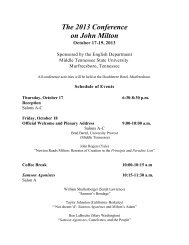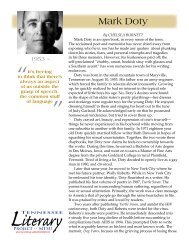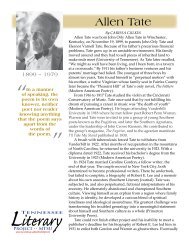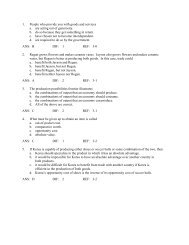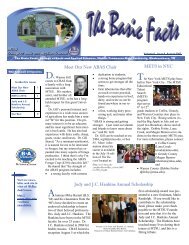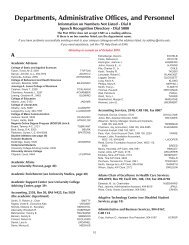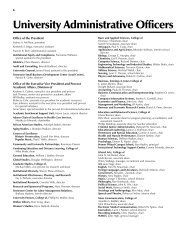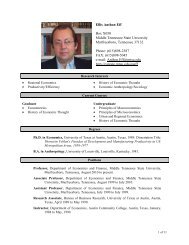Song of Silk - Middle Tennessee State University
Song of Silk - Middle Tennessee State University
Song of Silk - Middle Tennessee State University
Create successful ePaper yourself
Turn your PDF publications into a flip-book with our unique Google optimized e-Paper software.
3<br />
6. A Ditty from the Yimeng Mountain 沂 蒙 山 小 调 This is a folksong<br />
from the Shandong Province, China. Everybody likes Yimeng Mountain<br />
because it is so pretty: a gentle breeze sweeps over sheep on the green<br />
mountain, red sorghum decorates people’s happy life.<br />
7. The Murmuring Stream 小 河 淌 水 This is a folksong from the<br />
Yunnan Province, China. The moon came out, bright and bright; my<br />
boyfriend is in the remote mountainside. You are like the moon in the sky,<br />
my dear; ah, the murmuring stream is clear and clear. A cool breeze up the<br />
green mountain, my dear, do you hear my call again and again?<br />
8. Beautiful Mood 美 丽 的 心 情 Wind sends the doves to the starry sky;<br />
the moon shines upon our happy dancing. Let our dreams grow auspicious<br />
wings; let beautiful moods follow us everywhere.<br />
9. Long Sleeve 水 袖 This is a Chinese classical dance using flowing<br />
sleeves that incorporates the concept <strong>of</strong> yin and yang and elements <strong>of</strong><br />
Beijing opera and tai chi.<br />
10. L<strong>of</strong>ty Mountains and Flowing Water 高 山 流 水 There is a beautiful<br />
story behind the music: Bo Ya, a prominent qin player during the Spring<br />
and Autumn Period (771 to 403 BC) befriended Zhong Ziqi, a woodcutter,<br />
because Ziqi was the only person able to appreciate the haughty mountains<br />
and the running streams that Bo Ya tried to “describe” in his music. One<br />
day, after learning <strong>of</strong> Ziqi’s death, Bo Ya was so sad that he shattered the<br />
instrument and vowed never to play again, since no one else could<br />
understand his music like Ziqi did.<br />
and in their religion, the Tibetan people have worshipped the yaks. This<br />
piece incorporates the slow, swaying movements <strong>of</strong> the ox.<br />
13. Beijing Opera Music Instruments 京 剧 器 乐 系 列 演 示 A Beijing<br />
opera orchestra is divided into two groups. One is called wen chang,<br />
whose main function is to accompany actor’s singing. Wen chang is<br />
dominated by a stringed instrument called jinghu and is supplemented by<br />
plucked instruments such as yueqin and pipa. The other is wu chang,<br />
whose main function is to accompany acting, recitation, dancing and<br />
acrobatic fighting on stage. Wu chang usually plays percussion music<br />
instruments, such as drums, wooden clappers, gongs and cymbals.<br />
14. Sitting in the Palace 坐 宫 “Sitting in the Palace” is an excerpt from a<br />
famous jing ju (Beijing opera) play, Silang Visits His Mother. The play is<br />
set in the Northern <strong>Song</strong> Dynasty (960–1127), when the kingdom<br />
alternated between warfare and diplomacy with the Liao people in the<br />
northeast. In a battle against the troops <strong>of</strong> Liao, General Yang Silang’s<br />
father and brothers are killed. Captured by Liao armies, Silang does not<br />
reveal his true identity to anyone. The empress <strong>of</strong> Liao later betroths her<br />
daughter to Silang. Silang and the princess love each other very much and<br />
later have a son. One day, Silang hears his mother, a general, is in a<br />
fortified city <strong>of</strong> Liao to wage war. He is very eager to see his mother after<br />
15 years; however, he cannot pass the guarded gates unless he gets a<br />
golden arrow from the empress. Silang then reveals his true identity to the<br />
princess and asks her for help.<br />
11. New Take on a Tune “Sorrow on River Luo” 新 翻 《 罗 江 怨 》 <br />
“Sorrow on River Luo” is a guzheng tune from Shanxi area. Zhou Yanjia<br />
and Huang Zhenyu, two composers, put a new spin on the old tune.<br />
12. Cradle on Yak’s Back 牛 背 摇 篮 This is a Tibetan dance. Tibet is in<br />
western China, north <strong>of</strong> the Himalayas. In Tibet, yaks are very important<br />
to the society and economies <strong>of</strong> local people. Throughout their history



